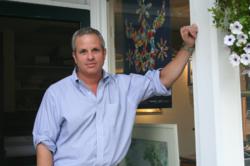Of course, what would these affairs be without the schmoozing with friends, and the renewal of old and forging of new professional relationships? To my retiring nature these affairs would be perfectly marvelous, yet even I found myself luxuriating in my peeps, as the young people say today (or at least did on some not too distant yesterday), both among my correspondents from the TradArch and Pro-Urb lists (which discuss classicism and urbanism), fellow members of the board of the New England chapter of the Institute of Classical Architecture & Art, not to mention complete strangers.
Looking down on us all from above was the founder of the classical revival itself, the late Henry Hope Reed. He has been fighting the Mods since back in the ’50s and ’60s, when he went mano-a-mano with Ada Louise Huxtable, defending against her efforts to inflict modernism on the tours of the Metropolitan Art Society, before she became a columnist for the New York Times. Henry’s The Golden City was bible to us all.
The Palladio Awards were to be a scene of high fives by winners but also of expressions of gratitude to my ICAA chapter’s departing president, John Margolis. I missed the event to dine with a former colleague on the Providence Journal’s editorial board, whom I had not seen for several years. But I hear that the awards went off commendably, including a generous public sendoff for John. I regret having missed this heartfelt presentation, but fortunately I was able to chat with John several times during the conference before he heads off to challenge the alternate coast.
John leaves shortly for a new job in Los Angeles, and the City of Angels will be the better, certainly the prettier, for it. The ICAA’s Southern California chapter is sure to hear from him. New England will miss him. John’s five years’ atop the chapter strengthened it immeasurably. The Bulfinch Awards were conceived under his esteemed predecessor Eric Daum (now treasurer) but instituted on John’s watch. The activities and programming of the chapter were expanded, as was its membership in no small amount – and he himself grew as a leader, manager and exponent of the classical tradition. When he won election five years ago I figured he’d be a fine fundraiser but that the true classicist in the contest, Sheldon Kostelecky, had been outvoted. John was all of the former and, it turns out, all of the latter as well – and now he hands over the reigns as president (after a vote of the board the week before) to Sheldon, the chapter’s founder, who during John’s administration has toiled with extraordinary dignity and effectiveness as chapter vice president for education. Sheldon has created the nation’s first online classical curriculum, now available through the Boston Architectural College. We are all confident that with a broader portfolio now as chapter president, Sheldon will advance John’s leadership on all fronts.
I also met the ICAA’s new national president, Peter Lyden, who also has a reputation as an excellent fundraiser but whose powers as a leader of classicists and the classical revival are, naturally, untested and unknown (at least to me). But he talks a good game, sports a fine necktie, and I am sure that all will be well down at the national on West 44th St.
For all the schmoozing I ended up doing, I regret that I missed an introduction to Clem Labine, who founded the conference after having founded and brought up a large menagerie of magazines devoted to the classical revival. Old Home Journal, which describes the restoration of old homes, and Traditional Building, which follows progress in the design and construction of larger classical projects, are, I think, merely the best known. What I know for sure is that if you go to any magazine rack in a book store, art store, airport or elsewhere, the number of journals on how to restore, renovate or build a traditional house outnumber those on how to do for modernist houses. To describe the degree of dominance in the market of Clem’s journalistic children and their offshoots is impossible to do with any modesty.
That’s because traditional homes are the choice of those who desire to live in a house, and has been thus for decades even in the face of an equal predominance of modernism in the establishment of architecture. Most larger works of architecture are designed by architects chosen by committees, and it shows. In contrast, the dominance of tradition in housing chosen by individuals is natural, and takes its place without the use of authoritarian methods needed by the modernists to keep their absurdist practices in power.
As is evident from Clem’s regular column on architecture, he recognizes that the next step for the classical revival is to even the playing field for traditional and classical proposals for major commissions to build the nation’s commercial and institutional infrastructure. That will not only require expanding the reputation of traditional work among the young but actively seeking to undermine the reputation of modernist work among the young and others who have yet to recognize that modernism, not just in practice but in principle, works not just against a beautiful civic environment but against a sustainable economic and natural environment.
Nobody understands this better than Clem, and he is, thankfully, in a position to propound his knowledge through a vast system of his own making. His publishing empire is the makers space of makers spaces.






There’s a vintage saying among photographers
that goes “if you ruin a portrait you will need to apologize, if you screw up a wedding you need to leave town”.
If you need to market your photography business online, there are
several different ways to go about it. Are you on top of each of
the decisions you are faced with.
LikeLike